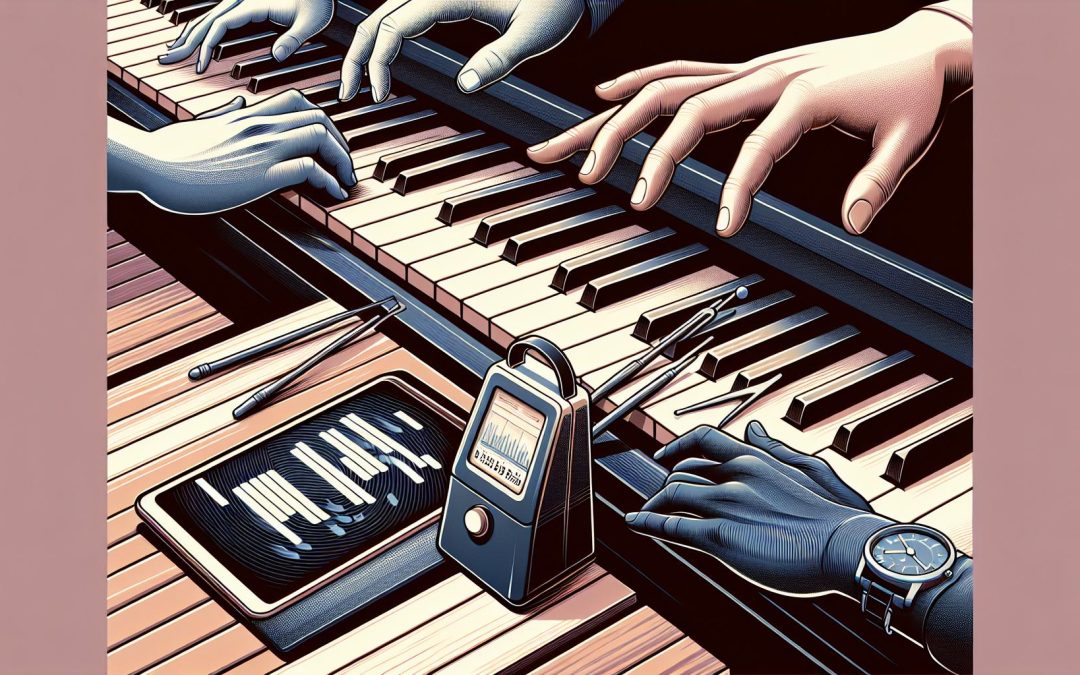In today's fast-paced world, finding time to practice the piano can feel like searching for a needle in a haystack. Yet, the desire to improve and the joy of playing don't diminish with our busy schedules. They're faced with a common dilemma: how to make the most of limited practice time without sacrificing progress or enjoyment.
Luckily, it's not about the quantity of time spent at the keyboard but the quality. With some smart strategies and a bit of creativity, they can maximize their practice sessions, ensuring that every minute counts. Whether it's during a lunch break or right before bed, there are ways to keep those fingers nimble and the music flowing.
Set Clear Goals
When time is of the essence, setting clear, achievable goals for each piano practice session can make a world of difference. Without a plan, it’s easy to waste precious minutes pondering what to work on, but with specific objectives in place, every second counts.
Determine What You Want to Achieve
Start by deciding what you wish to accomplish in your short practice sessions. Do you want to master a particular piece, improve your technique, or enhance your sight-reading skills? Whatever your goal, it's crucial to be as specific as possible. For instance, rather than aiming to "get better at piano," set a goal to "learn the first page of Beethoven’s Moonlight Sonata without mistakes."
Break Down Your Goals
After defining your broader objectives, break them down into smaller, more manageable tasks. This approach makes your goals feel less daunting and helps you focus on making incremental progress. Let's say you're working on a challenging piece. You might divide your goal into tasks like mastering the right-hand part, improving dynamics, and then combining hands smoothly.
Prioritize Your Goals
Given that your practice time is limited, prioritizing your goals becomes essential. Identify which objectives are most important to you and allocate your time accordingly. If you have a performance or an exam coming up, focus on the pieces or skills you'll need to showcase.
| Goal Priority | Task | Time Allocation |
|---|---|---|
| 1 | Master the right-hand part of Beethoven’s Moonlight Sonata | 15 minutes |
| 2 | Work on dynamics in Chopin’s Prelude in E minor | 10 minutes |
| 3 | Improve sight-reading with new, simple pieces | 5 minutes |
Set Realistic Deadlines
Timing is everything. Setting realistic deadlines for achieving your goals will help keep you motivated and on track. Be honest with yourself about what you can accomplish in each session. If you have 30 minutes to practice, don't cram an unrealistic amount of material into that time. Instead, select one or two focal points and commit to them fully.
Prioritize Techniques and Pieces

When time is of the essence, every minute at the piano counts. They can't afford to practice everything under the sun. That's why prioritizing techniques and pieces that align with their goals becomes crucial. It’s about making smart choices that ensure they're not just playing but improving during each session.
To start, they should categorize their practice into two main areas: technique and repertoire. Technique focuses on the foundational skills needed to play well, such as scales, arpeggios, and finger exercises. Repertoire, on the other hand, is about learning and perfecting pieces. Both are important, but depending on their time and goals, one might take precedence over the other.
Technique Focus
If their aim is to improve their overall piano playing skills, dedicating a significant portion of their limited time to technical exercises is essential. Here's a quick guide on how to prioritize techniques:
- Scales and arpeggios: They not only improve finger dexterity but also help in understanding key signatures.
- Finger exercises: Choose ones that address their weaknesses, whether it's finger independence or speed.
- Hanon exercises: Great for building strength. They might focus on exercises that target their specific needs.
Spend around 15-20 minutes on technical exercises, keeping them sharp and focused.
Repertoire Focus
When their goal is performance-ready, allocating time to learn and polish pieces is vital. Here’s how they can manage their repertoire practice efficiently:
- Choose wisely: They should select pieces that challenge them but are also achievable within their timeframe.
- Break it down: Tackle difficult sections first. Dividing the piece into smaller sections can make practice more manageable.
- Slow practice: It's more productive to practice slowly and accurately than to rush through mistakes.
They might alternate between technique and repertoire-focused sessions or combine both in a single practice, depending on their goals and time constraints.
- Short-term goals: These might include mastering a specific scale or learning a section of a piece.
- Long-term goals: Perhaps they’re aiming to perform at a recital or master a particularly challenging piece over several months
Utilize Short Bursts of Practice

In today's fast-paced world, finding large blocks of time to dedicate to piano practice can be a challenge. However, one should not be discouraged. Short bursts of practice, often referred to as micro-sessions, can be surprisingly effective. These sessions, ranging from five to twenty minutes, can fit into almost any schedule and can significantly improve a pianist's skills over time.
The key to making these short sessions productive lies in their focus and intensity. During each micro-session, a pianist should target a specific skill or piece. This might mean working on a particular scale, mastering a tricky bar in a piece, or improving finger dexterity with exercises. By zoning in on one aspect of playing, they'll make tangible progress, even in a short time.
Planning Ahead
For short bursts of practice to be effective, planning is crucial. They should decide in advance what they'll work on in each session. This planning might involve setting a week's practice schedule, where each day is dedicated to a different aspect of piano playing. Here's an example of how a week could be organized:
- Monday: Focus on scales
- Tuesday: Work on a specific challenging passage
- Wednesday: Practice arpeggios
- Thursday: Sight-reading exercises
- Friday: Review and polish a piece they're learning
- Saturday: Finger exercises for dexterity
- Sunday: Free choice or rest
By having a plan, they'll ensure that no time is wasted on deciding what to practice. Each micro-session becomes a targeted effort to improve a specific area of their musicianship.
Quality Over Quantity
In each short burst of practice, quality should always take precedence over quantity. It's better to play a scale correctly and with intention a few times than to mindlessly repeat it with errors. Slow, deliberate practice in these micro-sessions often yields better results than hurried, unfocused efforts.
Integrating Short Bursts Into Daily Routines
Integrating practice sessions into a daily routine can help ensure they happen. For instance, a morning person might find it beneficial to play for fifteen minutes after breakfast. Alternatively, for someone who finds they're more alert in the evening, setting aside time right before dinner could work best. These sessions don't have to disrupt the day but instead can be a pleasant interlude, a moment of focus and calm amid other activities.
Focus on Problem Areas

When time is scarce, it's tempting to play through the parts of a piece that sound best or are more enjoyable. However, concentrating on the sections that need the most work is far more effective in the long run. These are often the segments that are skipped over or played less frequently, but they're precisely where improvement is most needed.
Identifying these problem areas requires an honest self-assessment or feedback from a teacher. Once pinpointed, these sections should become the focus of one's micro-sessions. By zeroing in on the most challenging measures, progress becomes visible more quickly. This approach not only improves the problematic sections but also boosts overall confidence in playing the piece.
To make the most of this strategy, one could:
- Break down difficult passages into even smaller sections, focusing on just a few notes or measures at a time.
- Slow down the tempo significantly, allowing for more precise finger movements and better memory retention.
- Use a metronome to gradually increase the speed without sacrificing accuracy.
- Record practice sessions to monitor progress and identify subtleties that need further refinement.
It's also beneficial to alternate focus between different problem areas across practice sessions. This variety keeps the practice engaging and prevents frustration from settling in on particularly challenging parts. Moreover, by regularly rotating the segments being worked on, the learning process remains balanced and comprehensive.
Allowing oneself to focus on these challenging segments without the pressure to play through the entire piece each time can lead to remarkable improvements in overall performance. Rather than feeling overwhelmed by the sections that don't yet sound right, adopting a targeted approach transforms these hurdles into opportunities for growth. Over time, what were once stumbling blocks become the highlights of one's musical journey.
Integrating targeted practice into one's routine does not require extensive time commitments. Even five to ten minutes dedicated to working on a specific problem area can lead to noticeable progress over weeks and months. This focused effort, compounded daily, is the key to mastering difficult passages and elevating one's piano playing to new heights.
Make Use of Technology

In an age where time is often scarce, leveraging technology can revolutionize the way one practices piano. From apps that offer structured lessons to recording devices that allow for immediate feedback, the array of tools available is vast and varied. They not only optimize practice time but also make the process more engaging and efficient.
Apps and Software
One of the most significant advantages of using apps and software is the personalized learning experience they provide. Many of these tools come with features that can adjust to a player’s skill level, offering lessons and exercises tailored to their specific needs. Here are some notable benefits:
- Interactive Lessons: Certain apps use gamification to make learning both fun and effective, keeping users motivated through rewards and achievements for progress.
- Flexibility: Players can practice anytime, anywhere, as long as they have their device with them. This is particularly beneficial for those with unpredictable schedules.
- Variety: A wide range of musical pieces, from classical to contemporary, ensures that learners stay engaged and challenged.
- Instant Feedback: Many apps offer real-time feedback on timing, accuracy, and rhythm, helping to correct mistakes promptly.
Metronomes and Tuners
Using digital metronomes and tuners is another way technology can aid in efficient practice. These tools help maintain tempo and ensure the instrument is properly tuned, which are critical for productive practice sessions.
- Consistency: Digital metronomes provide a consistent beat that helps in developing a reliable sense of rhythm.
- Accuracy: Tuning apps ensure that the piano is in perfect pitch, which is essential for developing a good ear.
Recording Devices
Recording practice sessions and listening back can be incredibly beneficial for identifying areas that need improvement. With smartphones and tablets, high-quality recordings can be made without the need for expensive equipment. Here are a couple of reasons why recording practice sessions is useful:
- Self-Assessment: Listening to recordings allows players to critique their performance objectively.
- Progress Tracking: Keeping a library of recordings over time can showcase how much one has improved, serving as a motivational boost.
Conclusion
Embracing technology in piano practice offers a world of benefits that go beyond traditional methods. It's not just about saving time; it's about making every minute count. With the right apps and software, players can enjoy a more personalized and engaging learning experience. They'll find flexibility in their schedule and variety in their practice that keeps motivation high. Plus, tools like digital metronomes, tuners, and recording devices play a crucial role in maintaining quality and tracking progress. Ultimately, by integrating these technological advancements, learners can significantly enhance their piano skills, making the journey not only more efficient but also more enjoyable. So why not give it a try and see how it transforms your practice sessions?
Harlan Kilstein began playing piano during covid with no piano background at all. He taught himself how to play learning what to do and what not to do.
Today he's an advanced intermediate player and can help you grow in your skills because he learned all this on his own.







